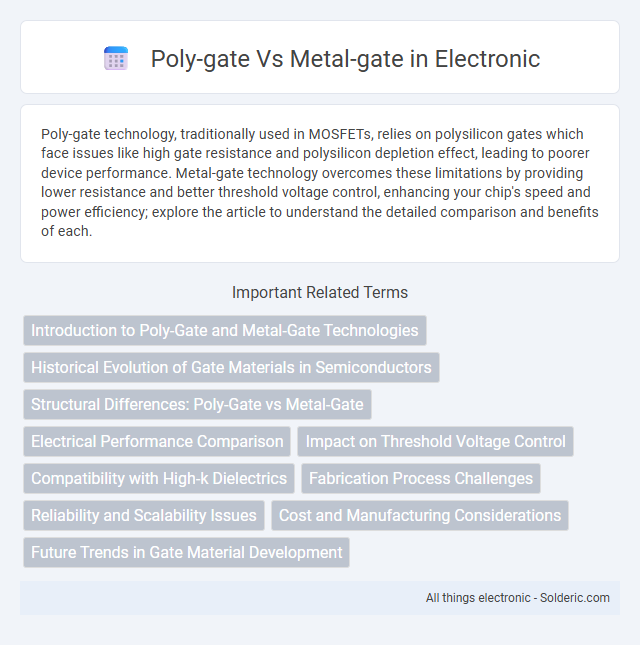Poly-gate technology, traditionally used in MOSFETs, relies on polysilicon gates which face issues like high gate resistance and polysilicon depletion effect, leading to poorer device performance. Metal-gate technology overcomes these limitations by providing lower resistance and better threshold voltage control, enhancing your chip's speed and power efficiency; explore the article to understand the detailed comparison and benefits of each.
Comparison Table
| Feature | Poly-Gate | Metal-Gate |
|---|---|---|
| Material | Heavily-doped polysilicon | High work-function metals (e.g., TiN, TaN) |
| Work Function | Variable, depends on doping | Precise, tunable for threshold voltage control |
| Gate Leakage | Higher due to polysilicon depletion | Lower, improved leakage control |
| Scalability | Limited for <10nm nodes | Ideal for advanced technology nodes (7nm, 5nm, below) |
| Performance | Moderate, affected by polysilicon depletion effect | Enhanced drive current, better performance |
| Compatibility | Used in older CMOS processes | Standard in modern FinFET and CMOS technologies |
| Manufacturing Complexity | Simple, well-established | More complex, requires additional process steps |
Introduction to Poly-Gate and Metal-Gate Technologies
Poly-gate technology utilizes polysilicon as the gate electrode material in MOSFET devices, offering good compatibility with silicon dioxide gate dielectrics but suffering from polysilicon depletion effects that impact performance. Metal-gate technology replaces the polysilicon gate with metals such as titanium nitride or tantalum nitride, reducing gate resistance and eliminating depletion effects to enhance transistor speed and scaling. Understanding your choice between poly-gate and metal-gate is crucial for optimizing semiconductor device performance and achieving advanced process nodes.
Historical Evolution of Gate Materials in Semiconductors
The historical evolution of gate materials in semiconductors transitioned from polysilicon gates, which dominated early CMOS technology due to their compatibility with silicon dioxide, to metal gates introduced in advanced nodes starting around the 45nm technology node to address polysilicon depletion effects and improve device performance. Metal gates offer superior electrical conductivity, reduced gate resistance, and better threshold voltage control, enabling further device scaling and enhanced transistor speed. This shift also facilitated the integration of high-k dielectrics, marking a critical milestone in semiconductor manufacturing innovation.
Structural Differences: Poly-Gate vs Metal-Gate
Poly-gate transistors use polysilicon as the gate material, which forms a silicon dioxide interface with the channel, while metal-gate transistors replace polysilicon with a metal layer to reduce gate resistance and improve performance. The poly-gate structure suffers from polysilicon depletion effects and higher gate leakage, whereas metal-gate technology leverages high-k dielectrics to enable better control of short-channel effects. Understanding these structural differences helps optimize transistor speed, power consumption, and scalability in advanced semiconductor devices, making metal-gates preferable for cutting-edge CMOS technologies.
Electrical Performance Comparison
Metal-gate transistors demonstrate superior electrical performance compared to poly-gate devices, with lower gate leakage current and enhanced drive current, resulting from better threshold voltage control and reduced short-channel effects. The metal gate's work function tuning capability improves carrier mobility and minimizes variability in advanced CMOS technologies. As a result, metal-gate FETs enable higher switching speeds and lower power consumption essential for modern high-performance integrated circuits.
Impact on Threshold Voltage Control
Poly-gate technology often experiences threshold voltage variability due to poly depletion effects that reduce gate control over the channel, leading to less precise voltage regulation. Metal-gate technology improves threshold voltage control by eliminating poly depletion and enabling work function tuning through metal selection, resulting in enhanced device stability and performance. Your circuits benefit from metal-gate transistors with better threshold voltage uniformity, supporting higher drive currents and improved energy efficiency.
Compatibility with High-k Dielectrics
Metal-gate technology demonstrates superior compatibility with high-k dielectrics compared to poly-gate materials, as metal gates reduce gate depletion effects and enable better threshold voltage control. High-k dielectrics paired with metal gates enhance device performance by minimizing gate leakage currents and improving transistor scalability. Poly-gate structures often suffer from increased gate leakage and interface issues when combined with high-k materials, limiting their effectiveness in advanced CMOS processes.
Fabrication Process Challenges
Poly-gate technology faces challenges with polysilicon depletion and gate resistance during scaling, complicating precise control in the fabrication process. Metal-gate technology reduces these issues by eliminating polysilicon depletion, but introduces complexities in work function tuning and integration with high-k dielectrics. The shift to metal-gate requires advanced deposition techniques and careful thermal budget management to maintain device reliability and performance.
Reliability and Scalability Issues
Poly-gate transistors suffer from increased gate leakage and threshold voltage instability as device dimensions shrink, leading to reduced reliability in advanced nodes. Metal-gate technology addresses these issues by offering lower gate resistance and improved work function control, enhancing device performance and reliability. Scalability is significantly better with metal-gate processes due to their compatibility with high-k dielectrics, enabling further miniaturization without compromising electrostatic integrity.
Cost and Manufacturing Considerations
Poly-gate technology offers lower manufacturing costs due to its simpler processing steps and established semiconductor fabrication infrastructure, making it cost-effective for legacy and bulk production. Metal-gate devices require more advanced deposition techniques and additional materials, increasing complexity and overall manufacturing expenses. Despite higher initial costs, metal-gate technology provides better electrical performance and scalability for cutting-edge semiconductor applications.
Future Trends in Gate Material Development
Future trends in gate material development emphasize replacing traditional poly-gate with advanced metal-gate technologies to enhance transistor performance and scalability. Metal-gates offer lower gate resistance and improved electrostatic control, critical for sub-5nm technology nodes in semiconductor manufacturing. Integration of high-k dielectrics with metal-gate stacks further reduces leakage currents and power consumption in next-generation CMOS devices.
Poly-gate vs Metal-gate Infographic

 solderic.com
solderic.com